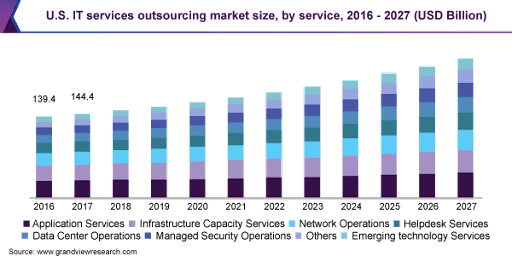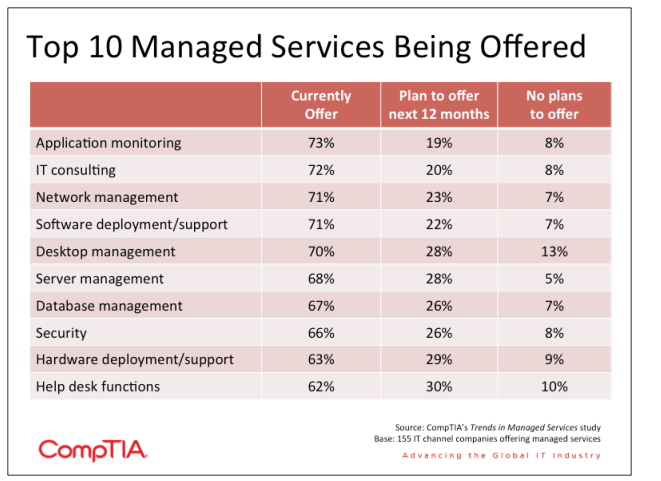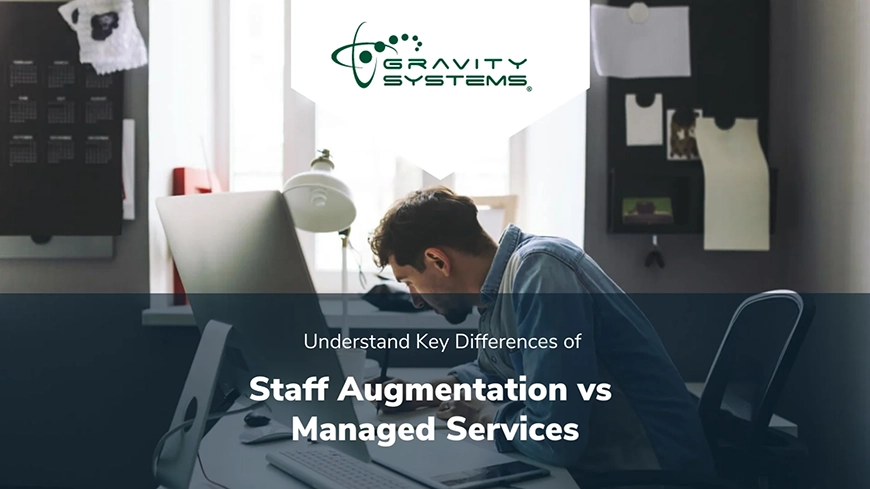Managed Services vs Staff Augmentation: A Closer Look
One of the most challenging hurdles many organizations face is scalability.
According to research conducted by the Manpower Group, 77% of companies globally report talent shortages, which directly impact their scalability.
|
“Talent shortages aren't just an HR issue; they're a business crisis that directly impacts an organization's bottom line." says Kent Morris, President of Gravity Systems |
Whether you're a startup looking to expand or an established company with fluctuating project demands, the question arises: How do you efficiently scale your workforce?
Do you hire more full-time staff, or do you outsource specific tasks? Staff Augmentation vs Managed Services is a recurring debate that tries to answer this vital question.
Feeling overwhelmed by your IT challenges?
Talk to us today to learn more about what we offer.
Know More
Staff Augmentation vs Managed Services: What are they?
Staff augmentation and managed services are both outsourcing strategies, but they differ in key aspects. Understanding these differences is crucial for businesses to select the model that best fits their requirements.
At its core, the dilemma between staff augmentation and managed services focuses on how to optimize your workforce and business processes.
What is Staff Augmentation?
Staff augmentation is an outsourcing model where you add external team members to your existing in-house team for a specific period or project. Staff augmentation is on the rise and how, in fact, the US IT staffing market is expected to reach around $39 billion by 2024.
This is often a more cost-effective solution for companies that want to maintain complete control over the project and their internal processes. By hiring specialized skill sets on a project-by-project basis, you save costs and maintain flexibility.

Source: Grand View Research
Pros of Staff Augmentation
1. Complete Control
With staff augmentation, you retain full management over both the project and the team. This means you have the final say in all decision-making processes, from project timelines to resource allocation.
If your organization has specialized internal processes or uses unique software tools, maintaining complete control can be crucial for project success.
2. Reduced Cost
One of the major advantages of staff augmentation is the potential for reduced cost.
Since you are hiring professionals for a specific project or for a limited period, you avoid the long-term financial commitments associated with hiring full-time employees, such as benefits and insurance. You only pay for the skills you need when you need them.
Need Help Managing Your IT Infrastructure?
Trust Gravity Systems Trust in Gravity Systems' expertise, backed by over 25 years in IT.
Learn More
3. Specialized Skills
Staff augmentation allows you to tap into a vast talent pool. This model enables you to bring in experts with specialized skills tailored to your project's needs.
Whether you need a data scientist, a UX designer, or a software developer familiar with a particular programming language, staff augmentation can fill the gap quickly and efficiently.
Cons of Staff Augmentation
1. Team Cohesion
Introducing new team members through staff augmentation can pose a risk to team dynamics. These external talents may not always mesh well with the existing team culture or work styles.
Additionally, augmented staff might be more accustomed to working independently and may not immediately adapt to your team's collaborative approach.
This can result in challenges such as communication gaps, misunderstandings, or even conflicts, which can ultimately impact the project's timeline and quality.
2. Limited Scope
Staff augmentation is often best suited for projects with a defined scope and timeframe. Once the project concludes or the contract ends, you may find yourself back at square one, searching for talent again.
For long-term projects or ongoing needs, this model can become cumbersome and less efficient than other outsourcing options.
3. Lack of Loyalty
Staff augmentation professionals are generally contracted for a specific period or project. Because they are not full-time, long-term employees, their loyalty to your company may not be as strong.
This can be a concern if you're working on projects that require a high degree of commitment or involve sensitive information.
What are Managed Services?
On the other hand, managed services refer to outsourcing specific functions or processes to a third-party service provider. A study by CISCO highlighted the growing reliance of businesses on managed services in 2023.
Unlike staff augmentation, a managed services model involves less control over the team members but offers the advantage of having specialized projects managed end-to-end by experts.
|
Explore How Managed IT Services Can Benefit Your Business: |
Pros of Managed Services
1. Reduced Cost
Opting for managed services can often be more budget-friendly than maintaining an in-house team for certain functions.
With managed services, you pay for a specific service rather than salaries, benefits, and training costs associated with full-time employees. This can lead to substantial savings, especially for specialized or technical tasks.
2. Expert Management
One of the strongest advantages of using managed services is the level of expertise you gain.
The third-party provider specializes in the service they offer and takes full responsibility for managing the projects. This often leads to higher levels of efficiency and quality, as the provider uses industry best practices and specialized tools to deliver the service.
3. Focus on Core Functions
By outsourcing specific tasks to a third-party provider, your in-house team can focus on core business functions.
This is particularly beneficial for businesses that have limited resources or that prefer to direct their in-house talent toward strategic objectives rather than operational tasks.

Source: CompTIA
Cons of Managed Services
1. Less Control
A significant downside of managed services is that you relinquish a degree of control over the projects or functions being outsourced.
The third-party provider will have their own methods and processes, which might not fully align with your company's practices or expectations. This can be challenging if you have specific ways of doing things or unique requirements.
2. Dependency on Provider
Another risk associated with managed services is the dependency on the third-party provider for success. If the provider fails to meet expectations or encounters operational issues, it directly affects your business.
This dependency can be nerve-wracking, especially for critical or time-sensitive projects.
Granular Comparison: Staff Augmentation vs Managed Services for Informed Decision-Making
|
Aspect |
Staff Augmentation |
Managed Services |
|
Primary Objective |
Focuses on task-specific outcomes based on set guidelines. |
Aims at comprehensive function management. |
|
Service Provider |
Acquired from staffing agencies, freelancers, or individual contractors. |
Delivered by specialized Managed Service Providers (MSPs). |
|
Skill Development |
Training on company-specific protocols is generally the client's responsibility. |
MSP usually trains its personnel in line with the service offered. |
|
Billing Method |
Costs calculated by multiplying hourly rate by the number of contracted individuals. |
Typically billed as a monthly or per-project fee |
|
Scope Definition |
Determined by explicit task outlines or contracts. |
Governed by Service Level Agreements (SLAs). |
|
Adaptability |
High adaptability for project changes but might require additional training. |
Lower adaptability but with a predefined set of services and outcomes. |
|
Client Involvement |
Requires ongoing client oversight for effective integration. |
Less client involvement, as MSPs manage the function autonomously. |
Staff Augmentation vs Managed Services: What to Choose?
The primary difference between staff augmentation vs managed services lies in control and project management.
If your organization values complete control and has well-defined internal processes, particularly in areas like software development, staff augmentation may be a better choice. It's like hiring extra soldiers for a battle you are leading yourself.
On the other hand, if you have tasks that are specialized and want them managed by experts without having to worry about the nitty-gritty, a managed services model might suit you best.
In this scenario, it’s like employing a team of mercenaries specialized in a certain form of warfare to take over a section of the battlefield.
Key Considerations for Choosing Between Managed Services vs Staff Augmentation
Here’s a quick glance at the fundamental considerations to weigh when deciding between staff augmentation and managed services. Cost, skills, control, and longevity each have their own implications depending on the model you choose.
Use this guide to align your specific needs and strategic objectives with the most suitable outsourcing model for your organization.
|
Key Consideration |
Staff Augmentation |
Managed Services |
|
Cost |
Offers reduced cost for short-term needs. |
Often budget-friendly but may require long-term contracts. |
|
Skills |
Ideal for specialized skills on short-term projects. |
Expertise is provided, but generally in a broader domain. |
|
Control |
Maintains complete control over the project and team. |
Less control as functions are outsourced to a third party. |
|
Longevity |
Best suited for short-term or specific projects. |
Offers more stability for long-term and complex projects |
Staff Augmentation Vs Managed Services: Make the Right Choice With Gravity System
The debate between staff augmentation vs managed services doesn't have a one-size-fits-all answer. The right choice depends on your organization’s specific needs, be it cost-effective scaling, specialized skill sets, or control over the project.
Still confused between managed services vs staff augmentation.
With Gravity Systems, you're not navigating this decision alone. We offer customized solutions designed to meet your unique business challenges.
Are you prepared to adapt to the ever-changing IT environment? Consult with Gravity Systems today. Together, we'll chart the course of your IT future.






